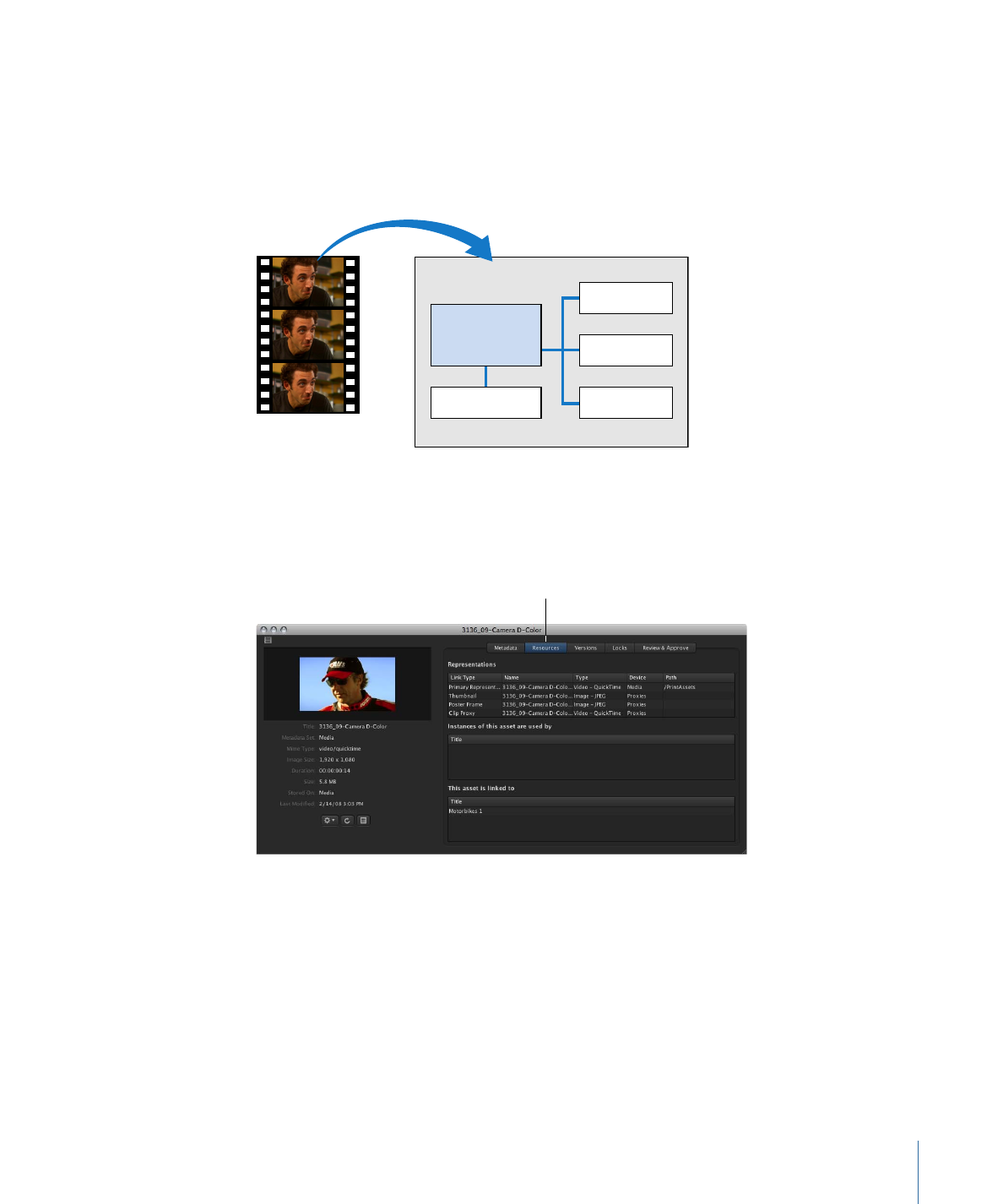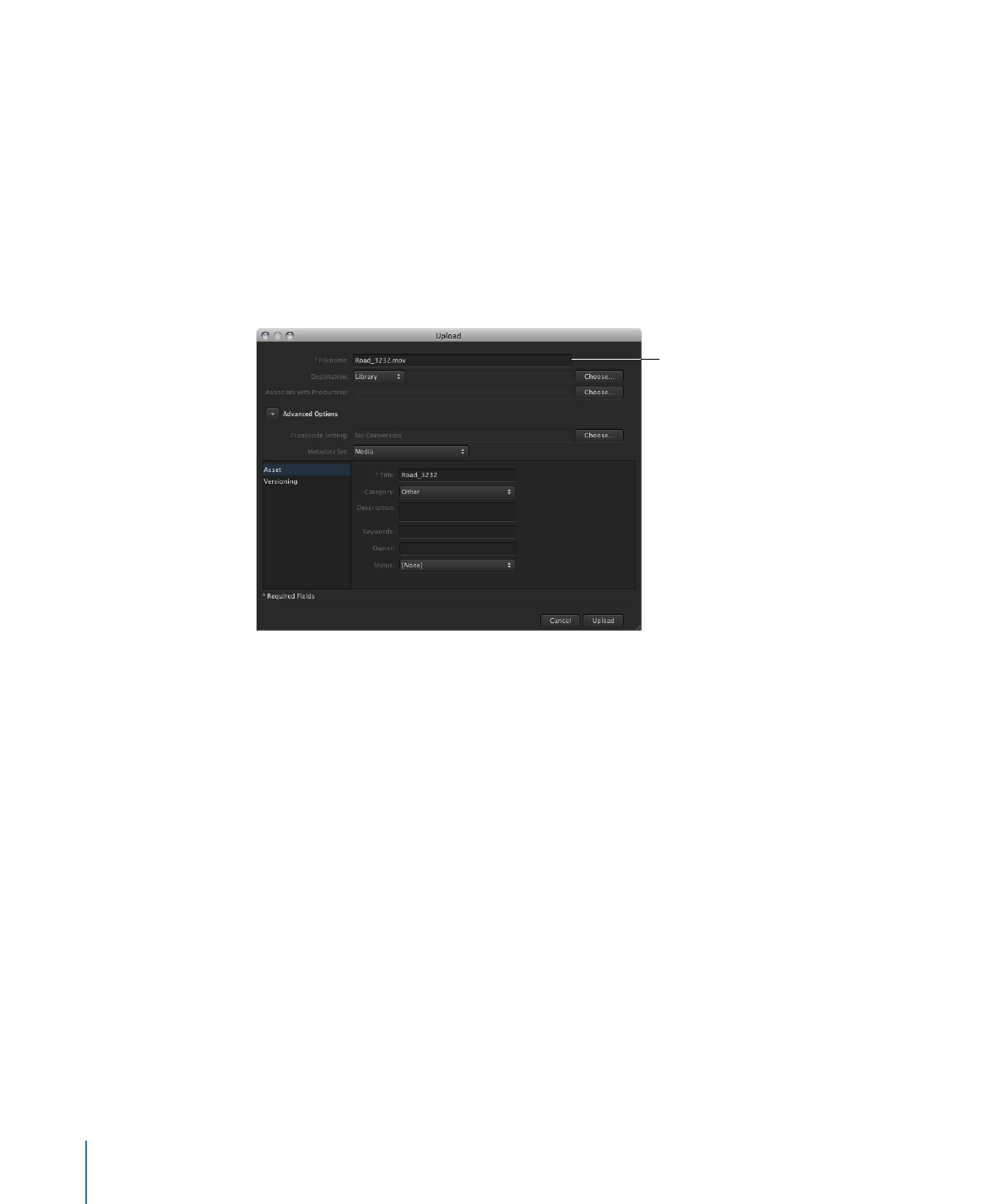
Uploading Media Files
When you upload a media or project file to Final Cut Server, the asset that is created
contains the original media file, which Final Cut Server calls the primary representation.
At upload, Final Cut Server creates proxy files for certain types of media assets. Proxy files
are copies of the primary representation that are used for certain operations within
Final Cut Server.
If the file being uploaded is a graphics or video file, Final Cut Server creates two proxy
graphics files: a Poster frame and a Thumbnail. These are used to represent the asset’s
media within Final Cut Server.
If the file being uploaded is a video asset, Final Cut Server also creates a Clip Proxy file.
The Clip Proxy file is created by transcoding the primary representation file to a
lower-resolution codec. The Clip Proxy is used for viewing the file in Final Cut Server.
32
Chapter 3
Uploading Files to Final Cut Server

Here’s an example. When you upload an uncompressed HD video clip to Final Cut Server,
a Final Cut Server asset is created. This asset holds the original file (the primary
representation). The original file is also transcoded to create the Clip Proxy file, and JPEG
images are created to be used as Thumbnail and Poster frame proxy files for the asset.
Media file
Media asset
Clip Proxy
Thumbnail
Poster frame
Metadata
Primary
representation
Upload video clip to Final Cut Server
After the upload is complete, you can view a list of the proxy files created for the asset
in the Resources pane of the asset’s info window.
You can see proxy files
created for the asset in
the Resources pane of
the asset info window.
You can upload one or more media files to Final Cut Server. When you upload multiple
media files, keep in mind that any setting you define in the Multiple Upload window,
including metadata, will apply to all the files being uploaded. For example, if you specify
a transcode format, all of the files being uploaded will be transcoded.
Important:
It is recommended that you include file extensions on all files uploaded to
Final Cut Server.
33
Chapter 3
Uploading Files to Final Cut Server

To upload one or more media files
1
Do one of the following:
• Drag the media file or files that you want to upload from the Finder, the desktop, or a
connected volume to the column on the left of the Final Cut Server main window, the
Assets pane, or a production.
• Choose Upload File from the Server pop-up menu, select the media file or files in the
file browser that appears, then click Upload.
Depending on the number of files you uploaded, the Upload, Link Upload, or Multiple
Upload window appears.
The Upload window
includes an editable
Filename field.
The Upload windows are very similar. In the Upload and Link Upload windows, you can
enter a filename for the asset (the filename is entered automatically). In the Multiple
Upload window, the filename field is hidden, and each asset being uploaded is
automatically named with the filename.
Note: You can change an asset’s title at any time after uploading in the asset info window’s
Metadata pane.
2
Some of the information and metadata in the Upload or Upload Multiple window is
automatically entered. You can change the metadata set from the Metadata set pop-up
menu and add metadata for the new asset or assets.
Important:
If you are uploading a file that you previously added metadata to using the
default QuickTime annotation fields, you must choose the Media metadata set for the
asset. When you do this, the metadata that was assigned to the file in QuickTime appears
in Final Cut Server in the QuickTime metadata group of the Media metadata set. If you
apply any other metadata set to the asset, the QuickTime metadata will not appear in
the Final Cut Server asset.
Remember that all the metadata you apply for a multiple upload will be attached to each
of the assets being created.
34
Chapter 3
Uploading Files to Final Cut Server

3
If necessary, choose a new destination device from the Destination pop-up menu. This
specifies the device on which the file will be stored. If you have questions about which
device to choose, contact your Final Cut Server administrator.
Note: Media and Library are the primary Final Cut Server devices. Talk with your
Final Cut Server administrator about which other configured devices are appropriate for
media file storage.
4
If you want to group the media asset or assets in a production, click Choose at the right
of the Associate with Production field and specify a production. (If you dragged the file
into a production in step 1, this field will automatically display the path to that production.)
See
Organizing Assets in Final Cut Server
for more information.
5
If you want to convert the original media file or files to a different codec, click the Choose
button and then select a new transcode setting in the window that appears.
6
Click Begin Upload to create assets from the media file or files.
The upload begins. The upload progress is displayed above the Information pane in the
bottom-left corner of the Final Cut Server main window.
7
To monitor the progress of the file upload, click the Downloads and Uploads button to
display the Downloads & Uploads window.
8
After the file is uploaded, click “Assets created by me” listed under the My Smart Searches
heading to view the new asset or assets that you just uploaded.
For information about how to get information about the asset that was just created, see
About the Asset Info Window
.